Leadership & Organisations Coursework: Indian Education Issues
VerifiedAdded on 2020/03/04
|15
|3028
|359
Report
AI Summary
This report examines the multifaceted challenges within the Indian education system. It begins with an introduction that outlines the aims, objectives, problem statement, and research questions concerning the Indian education system. The study delves into the historical context of education in India, tracing its evolution from ancient Gurukul systems to the influence of British colonization and the subsequent implementation of the Right to Education. The research questions explore issues within the Indian education system, especially amongst financially marginalized groups and the application of the Right to Education in rural sectors. The methodology section outlines the use of secondary research, including a literature review, to gather relevant information on the topic, focusing on the challenges faced by the marginalized and financially weak groups. The significance of the study is highlighted by the importance of literacy rate as a key indicator of economic development in India. The expected outcomes of the research focus on identifying issues that make education a burden, particularly for marginalized groups, and the impact of privatization on the accessibility of education. The report concludes by analyzing the issues within the Indian education system and suggests potential solutions and future research directions. The report is a valuable resource for understanding the complexities of education in India and the challenges that must be addressed to improve the educational landscape.
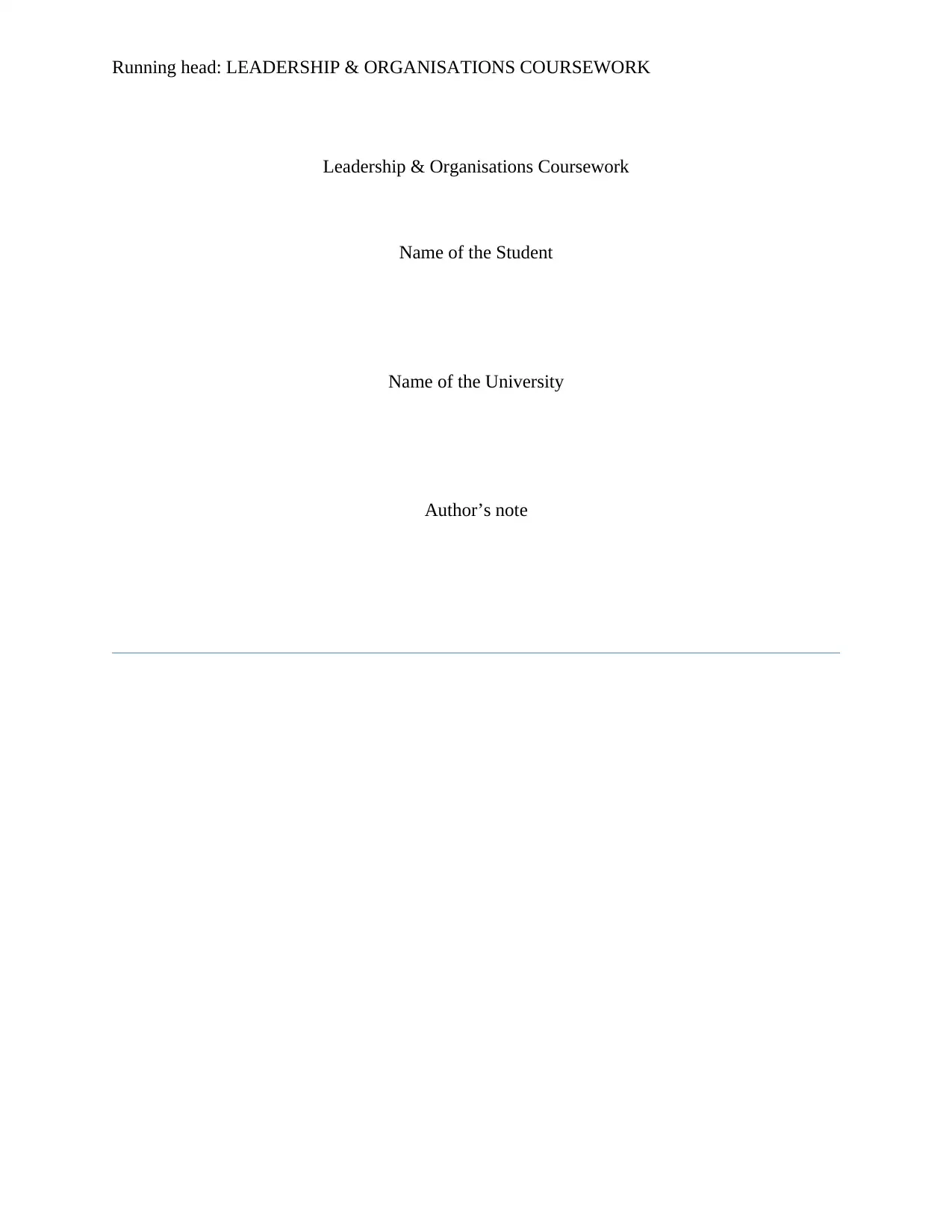
Running head: LEADERSHIP & ORGANISATIONS COURSEWORK
Leadership & Organisations Coursework
Name of the Student
Name of the University
Author’s note
Leadership & Organisations Coursework
Name of the Student
Name of the University
Author’s note
Paraphrase This Document
Need a fresh take? Get an instant paraphrase of this document with our AI Paraphraser
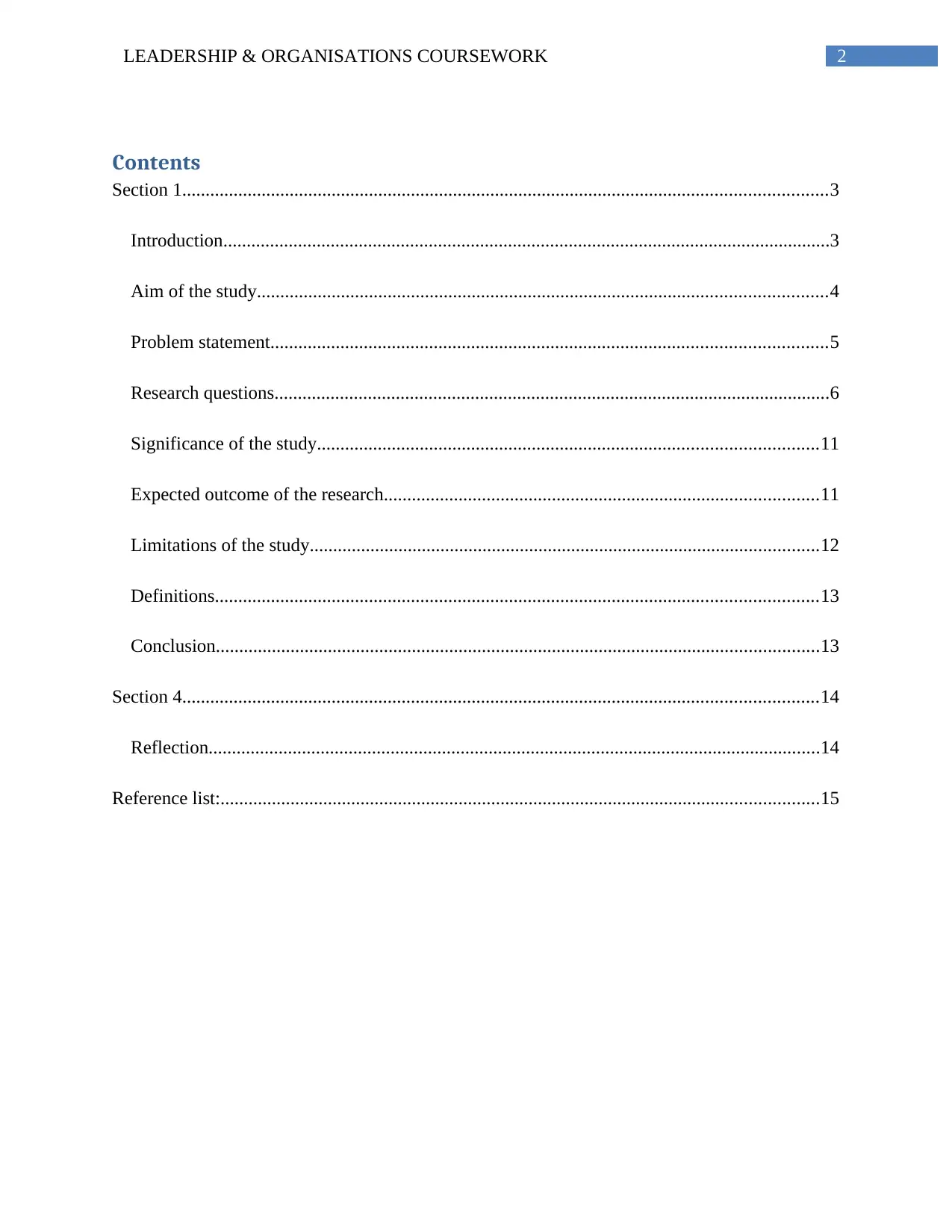
2LEADERSHIP & ORGANISATIONS COURSEWORK
Contents
Section 1..........................................................................................................................................3
Introduction..................................................................................................................................3
Aim of the study..........................................................................................................................4
Problem statement.......................................................................................................................5
Research questions.......................................................................................................................6
Significance of the study...........................................................................................................11
Expected outcome of the research.............................................................................................11
Limitations of the study.............................................................................................................12
Definitions.................................................................................................................................13
Conclusion.................................................................................................................................13
Section 4........................................................................................................................................14
Reflection...................................................................................................................................14
Reference list:................................................................................................................................15
Contents
Section 1..........................................................................................................................................3
Introduction..................................................................................................................................3
Aim of the study..........................................................................................................................4
Problem statement.......................................................................................................................5
Research questions.......................................................................................................................6
Significance of the study...........................................................................................................11
Expected outcome of the research.............................................................................................11
Limitations of the study.............................................................................................................12
Definitions.................................................................................................................................13
Conclusion.................................................................................................................................13
Section 4........................................................................................................................................14
Reflection...................................................................................................................................14
Reference list:................................................................................................................................15
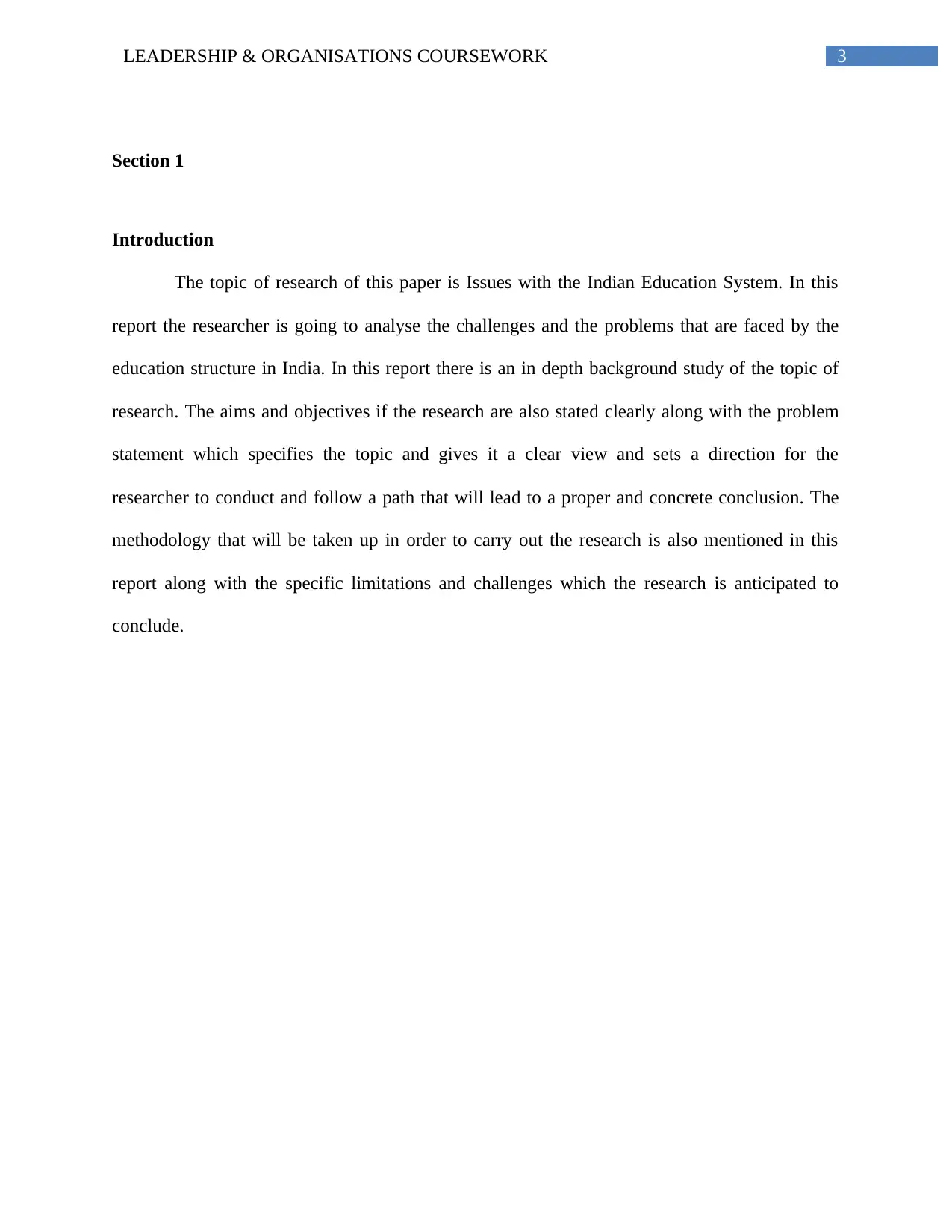
3LEADERSHIP & ORGANISATIONS COURSEWORK
Section 1
Introduction
The topic of research of this paper is Issues with the Indian Education System. In this
report the researcher is going to analyse the challenges and the problems that are faced by the
education structure in India. In this report there is an in depth background study of the topic of
research. The aims and objectives if the research are also stated clearly along with the problem
statement which specifies the topic and gives it a clear view and sets a direction for the
researcher to conduct and follow a path that will lead to a proper and concrete conclusion. The
methodology that will be taken up in order to carry out the research is also mentioned in this
report along with the specific limitations and challenges which the research is anticipated to
conclude.
Section 1
Introduction
The topic of research of this paper is Issues with the Indian Education System. In this
report the researcher is going to analyse the challenges and the problems that are faced by the
education structure in India. In this report there is an in depth background study of the topic of
research. The aims and objectives if the research are also stated clearly along with the problem
statement which specifies the topic and gives it a clear view and sets a direction for the
researcher to conduct and follow a path that will lead to a proper and concrete conclusion. The
methodology that will be taken up in order to carry out the research is also mentioned in this
report along with the specific limitations and challenges which the research is anticipated to
conclude.
⊘ This is a preview!⊘
Do you want full access?
Subscribe today to unlock all pages.

Trusted by 1+ million students worldwide
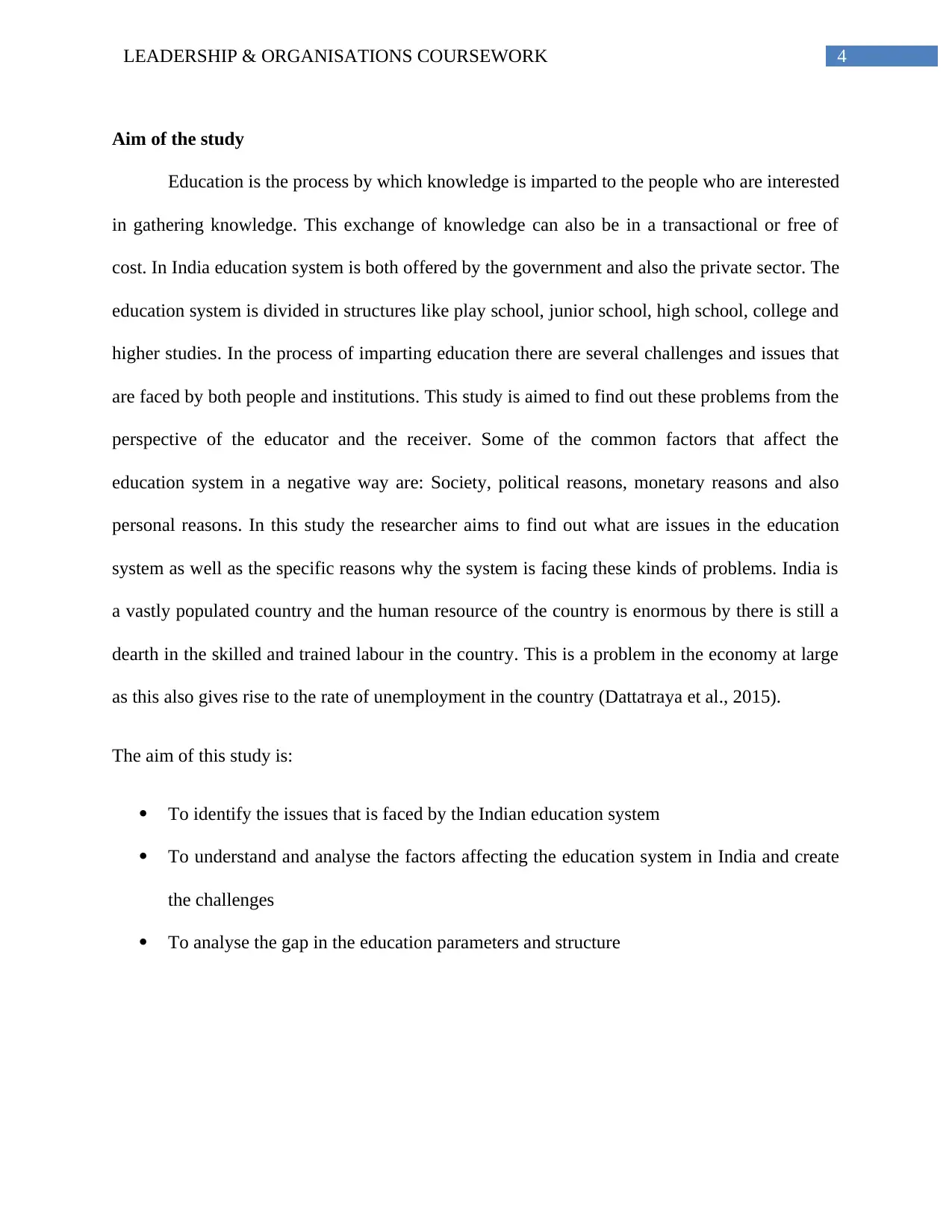
4LEADERSHIP & ORGANISATIONS COURSEWORK
Aim of the study
Education is the process by which knowledge is imparted to the people who are interested
in gathering knowledge. This exchange of knowledge can also be in a transactional or free of
cost. In India education system is both offered by the government and also the private sector. The
education system is divided in structures like play school, junior school, high school, college and
higher studies. In the process of imparting education there are several challenges and issues that
are faced by both people and institutions. This study is aimed to find out these problems from the
perspective of the educator and the receiver. Some of the common factors that affect the
education system in a negative way are: Society, political reasons, monetary reasons and also
personal reasons. In this study the researcher aims to find out what are issues in the education
system as well as the specific reasons why the system is facing these kinds of problems. India is
a vastly populated country and the human resource of the country is enormous by there is still a
dearth in the skilled and trained labour in the country. This is a problem in the economy at large
as this also gives rise to the rate of unemployment in the country (Dattatraya et al., 2015).
The aim of this study is:
To identify the issues that is faced by the Indian education system
To understand and analyse the factors affecting the education system in India and create
the challenges
To analyse the gap in the education parameters and structure
Aim of the study
Education is the process by which knowledge is imparted to the people who are interested
in gathering knowledge. This exchange of knowledge can also be in a transactional or free of
cost. In India education system is both offered by the government and also the private sector. The
education system is divided in structures like play school, junior school, high school, college and
higher studies. In the process of imparting education there are several challenges and issues that
are faced by both people and institutions. This study is aimed to find out these problems from the
perspective of the educator and the receiver. Some of the common factors that affect the
education system in a negative way are: Society, political reasons, monetary reasons and also
personal reasons. In this study the researcher aims to find out what are issues in the education
system as well as the specific reasons why the system is facing these kinds of problems. India is
a vastly populated country and the human resource of the country is enormous by there is still a
dearth in the skilled and trained labour in the country. This is a problem in the economy at large
as this also gives rise to the rate of unemployment in the country (Dattatraya et al., 2015).
The aim of this study is:
To identify the issues that is faced by the Indian education system
To understand and analyse the factors affecting the education system in India and create
the challenges
To analyse the gap in the education parameters and structure
Paraphrase This Document
Need a fresh take? Get an instant paraphrase of this document with our AI Paraphraser
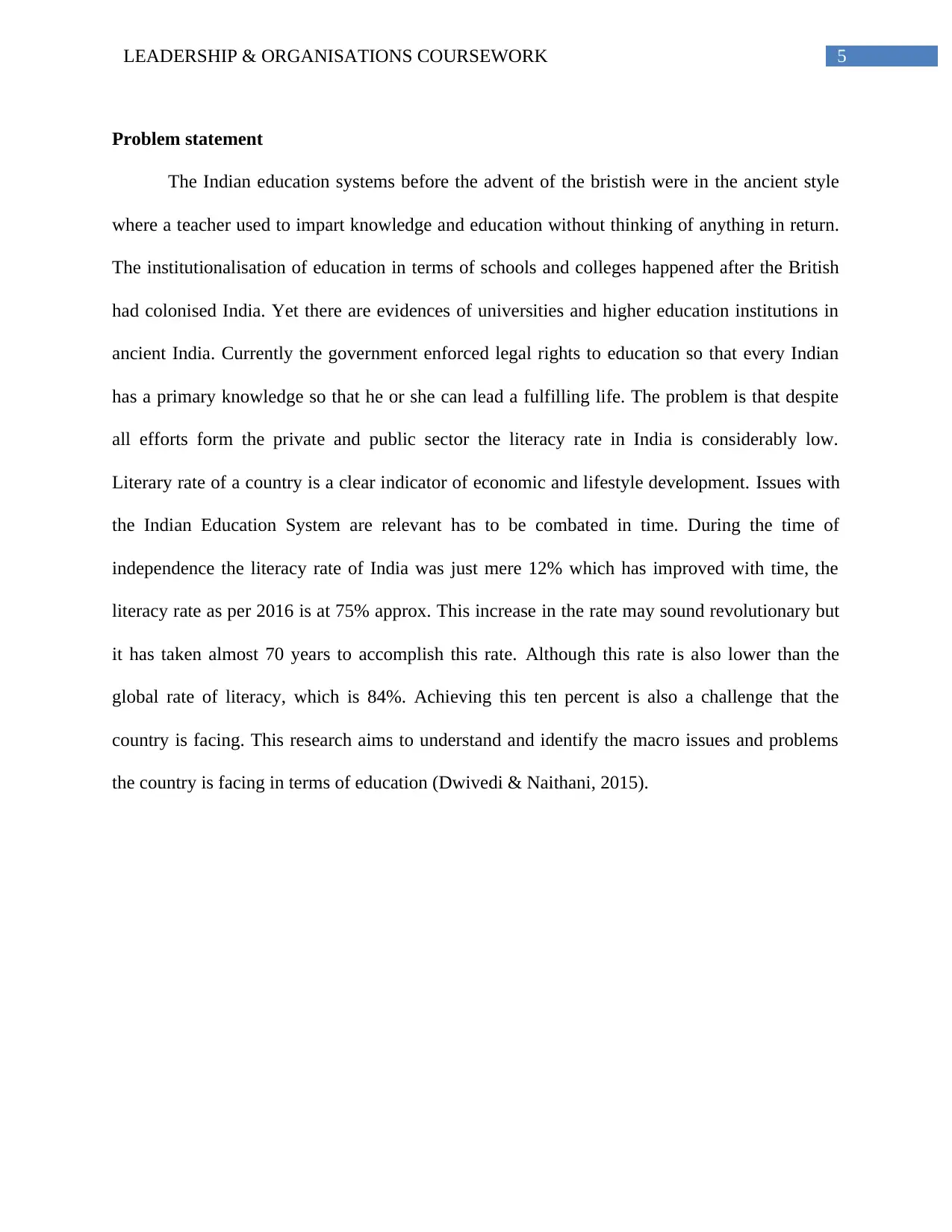
5LEADERSHIP & ORGANISATIONS COURSEWORK
Problem statement
The Indian education systems before the advent of the bristish were in the ancient style
where a teacher used to impart knowledge and education without thinking of anything in return.
The institutionalisation of education in terms of schools and colleges happened after the British
had colonised India. Yet there are evidences of universities and higher education institutions in
ancient India. Currently the government enforced legal rights to education so that every Indian
has a primary knowledge so that he or she can lead a fulfilling life. The problem is that despite
all efforts form the private and public sector the literacy rate in India is considerably low.
Literary rate of a country is a clear indicator of economic and lifestyle development. Issues with
the Indian Education System are relevant has to be combated in time. During the time of
independence the literacy rate of India was just mere 12% which has improved with time, the
literacy rate as per 2016 is at 75% approx. This increase in the rate may sound revolutionary but
it has taken almost 70 years to accomplish this rate. Although this rate is also lower than the
global rate of literacy, which is 84%. Achieving this ten percent is also a challenge that the
country is facing. This research aims to understand and identify the macro issues and problems
the country is facing in terms of education (Dwivedi & Naithani, 2015).
Problem statement
The Indian education systems before the advent of the bristish were in the ancient style
where a teacher used to impart knowledge and education without thinking of anything in return.
The institutionalisation of education in terms of schools and colleges happened after the British
had colonised India. Yet there are evidences of universities and higher education institutions in
ancient India. Currently the government enforced legal rights to education so that every Indian
has a primary knowledge so that he or she can lead a fulfilling life. The problem is that despite
all efforts form the private and public sector the literacy rate in India is considerably low.
Literary rate of a country is a clear indicator of economic and lifestyle development. Issues with
the Indian Education System are relevant has to be combated in time. During the time of
independence the literacy rate of India was just mere 12% which has improved with time, the
literacy rate as per 2016 is at 75% approx. This increase in the rate may sound revolutionary but
it has taken almost 70 years to accomplish this rate. Although this rate is also lower than the
global rate of literacy, which is 84%. Achieving this ten percent is also a challenge that the
country is facing. This research aims to understand and identify the macro issues and problems
the country is facing in terms of education (Dwivedi & Naithani, 2015).
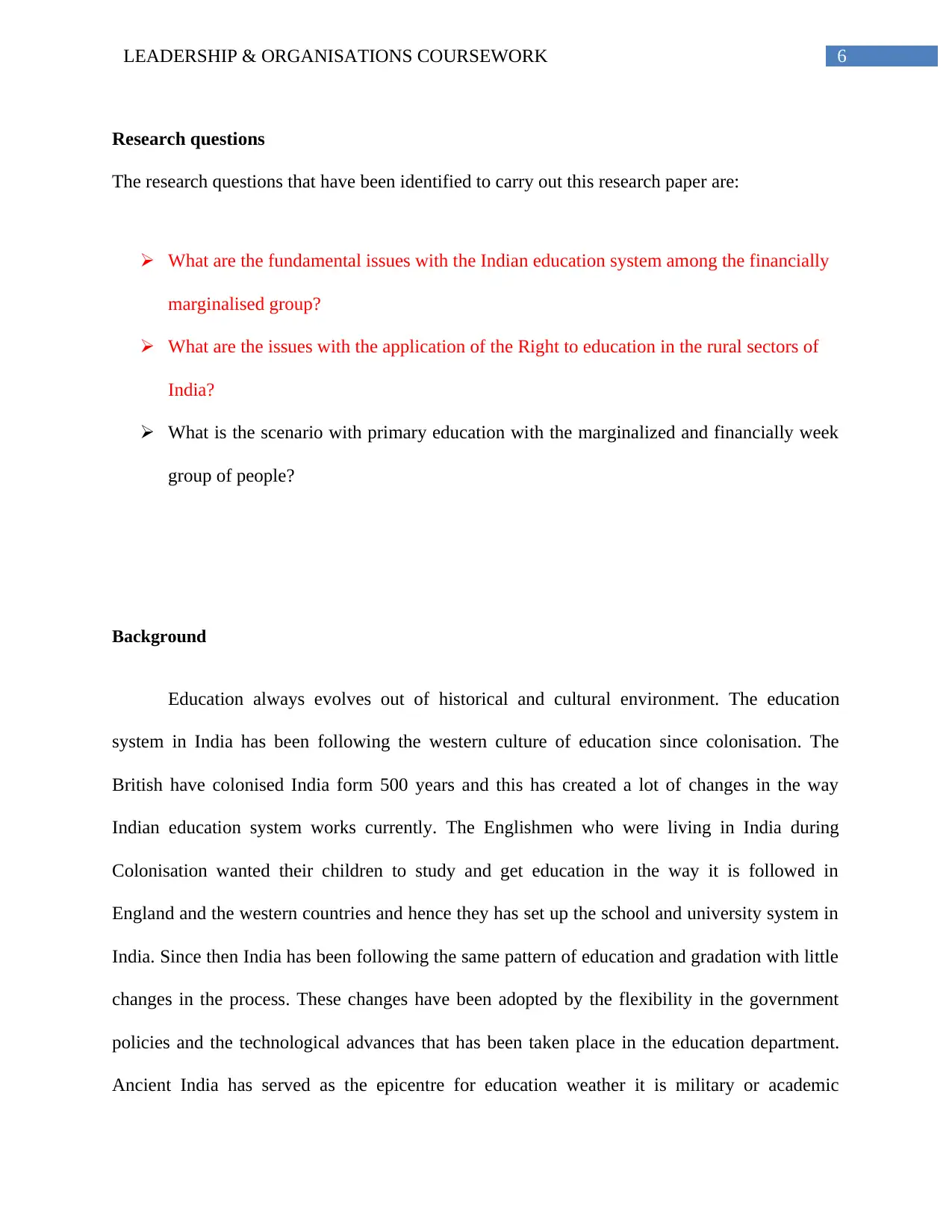
6LEADERSHIP & ORGANISATIONS COURSEWORK
Research questions
The research questions that have been identified to carry out this research paper are:
What are the fundamental issues with the Indian education system among the financially
marginalised group?
What are the issues with the application of the Right to education in the rural sectors of
India?
What is the scenario with primary education with the marginalized and financially week
group of people?
Background
Education always evolves out of historical and cultural environment. The education
system in India has been following the western culture of education since colonisation. The
British have colonised India form 500 years and this has created a lot of changes in the way
Indian education system works currently. The Englishmen who were living in India during
Colonisation wanted their children to study and get education in the way it is followed in
England and the western countries and hence they has set up the school and university system in
India. Since then India has been following the same pattern of education and gradation with little
changes in the process. These changes have been adopted by the flexibility in the government
policies and the technological advances that has been taken place in the education department.
Ancient India has served as the epicentre for education weather it is military or academic
Research questions
The research questions that have been identified to carry out this research paper are:
What are the fundamental issues with the Indian education system among the financially
marginalised group?
What are the issues with the application of the Right to education in the rural sectors of
India?
What is the scenario with primary education with the marginalized and financially week
group of people?
Background
Education always evolves out of historical and cultural environment. The education
system in India has been following the western culture of education since colonisation. The
British have colonised India form 500 years and this has created a lot of changes in the way
Indian education system works currently. The Englishmen who were living in India during
Colonisation wanted their children to study and get education in the way it is followed in
England and the western countries and hence they has set up the school and university system in
India. Since then India has been following the same pattern of education and gradation with little
changes in the process. These changes have been adopted by the flexibility in the government
policies and the technological advances that has been taken place in the education department.
Ancient India has served as the epicentre for education weather it is military or academic
⊘ This is a preview!⊘
Do you want full access?
Subscribe today to unlock all pages.

Trusted by 1+ million students worldwide
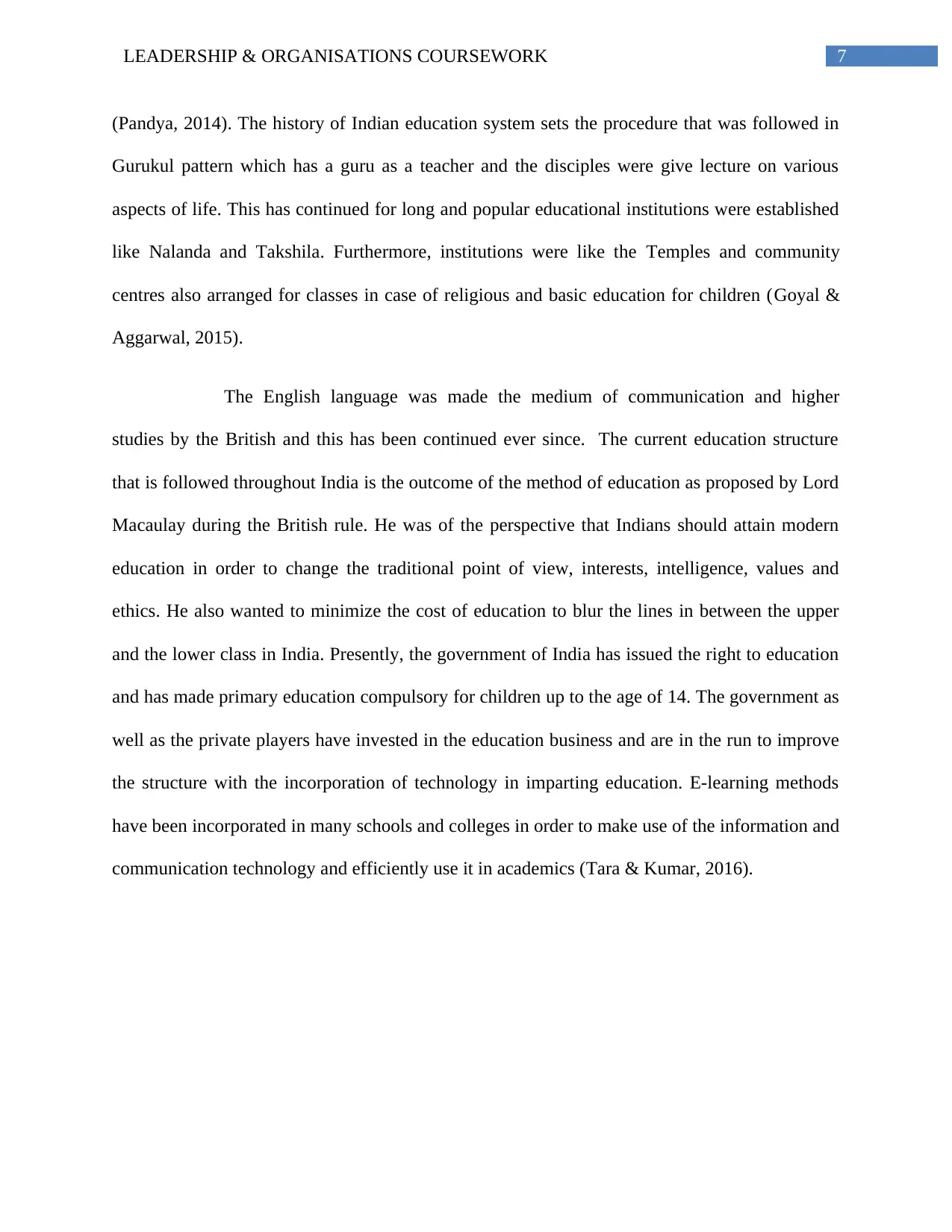
7LEADERSHIP & ORGANISATIONS COURSEWORK
(Pandya, 2014). The history of Indian education system sets the procedure that was followed in
Gurukul pattern which has a guru as a teacher and the disciples were give lecture on various
aspects of life. This has continued for long and popular educational institutions were established
like Nalanda and Takshila. Furthermore, institutions were like the Temples and community
centres also arranged for classes in case of religious and basic education for children (Goyal &
Aggarwal, 2015).
The English language was made the medium of communication and higher
studies by the British and this has been continued ever since. The current education structure
that is followed throughout India is the outcome of the method of education as proposed by Lord
Macaulay during the British rule. He was of the perspective that Indians should attain modern
education in order to change the traditional point of view, interests, intelligence, values and
ethics. He also wanted to minimize the cost of education to blur the lines in between the upper
and the lower class in India. Presently, the government of India has issued the right to education
and has made primary education compulsory for children up to the age of 14. The government as
well as the private players have invested in the education business and are in the run to improve
the structure with the incorporation of technology in imparting education. E-learning methods
have been incorporated in many schools and colleges in order to make use of the information and
communication technology and efficiently use it in academics (Tara & Kumar, 2016).
(Pandya, 2014). The history of Indian education system sets the procedure that was followed in
Gurukul pattern which has a guru as a teacher and the disciples were give lecture on various
aspects of life. This has continued for long and popular educational institutions were established
like Nalanda and Takshila. Furthermore, institutions were like the Temples and community
centres also arranged for classes in case of religious and basic education for children (Goyal &
Aggarwal, 2015).
The English language was made the medium of communication and higher
studies by the British and this has been continued ever since. The current education structure
that is followed throughout India is the outcome of the method of education as proposed by Lord
Macaulay during the British rule. He was of the perspective that Indians should attain modern
education in order to change the traditional point of view, interests, intelligence, values and
ethics. He also wanted to minimize the cost of education to blur the lines in between the upper
and the lower class in India. Presently, the government of India has issued the right to education
and has made primary education compulsory for children up to the age of 14. The government as
well as the private players have invested in the education business and are in the run to improve
the structure with the incorporation of technology in imparting education. E-learning methods
have been incorporated in many schools and colleges in order to make use of the information and
communication technology and efficiently use it in academics (Tara & Kumar, 2016).
Paraphrase This Document
Need a fresh take? Get an instant paraphrase of this document with our AI Paraphraser
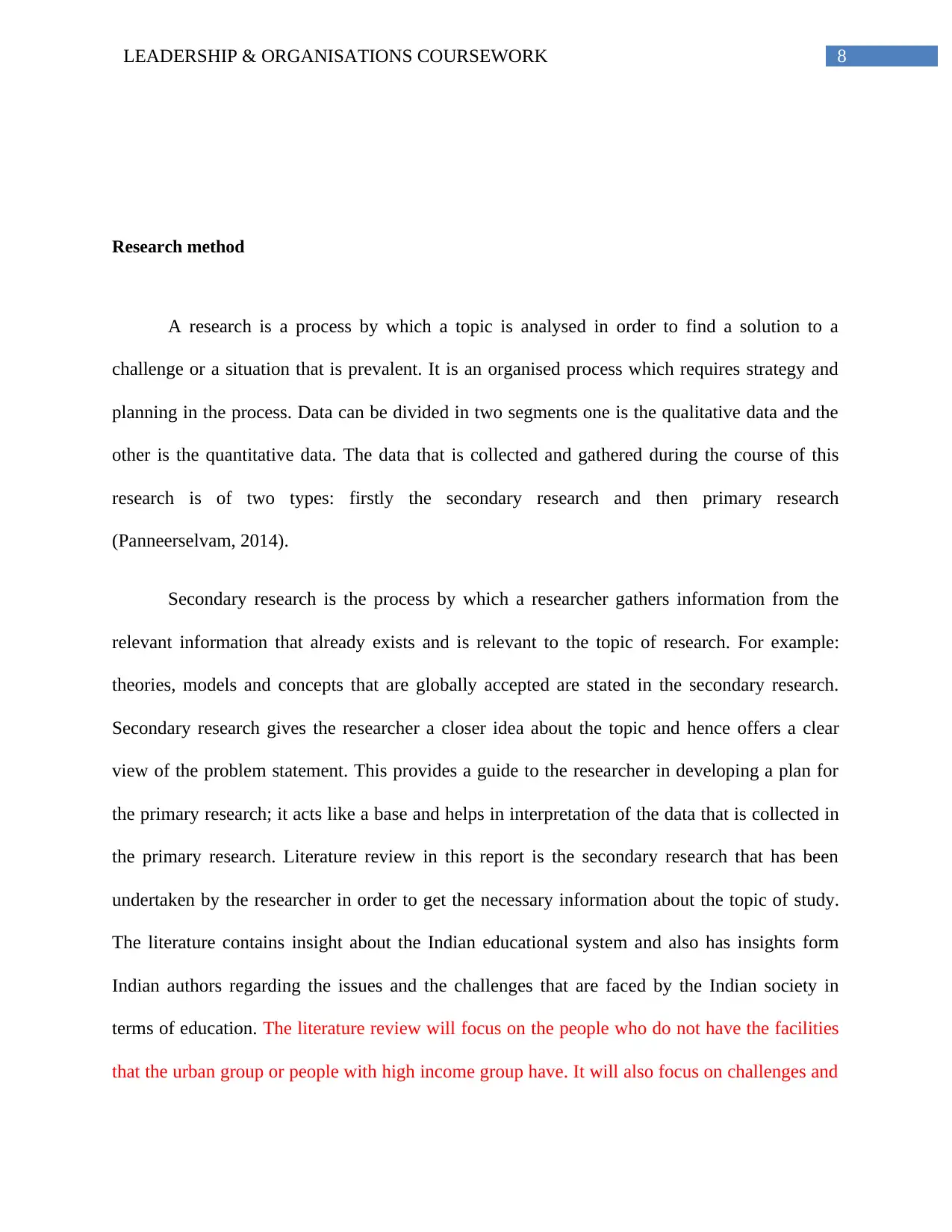
8LEADERSHIP & ORGANISATIONS COURSEWORK
Research method
A research is a process by which a topic is analysed in order to find a solution to a
challenge or a situation that is prevalent. It is an organised process which requires strategy and
planning in the process. Data can be divided in two segments one is the qualitative data and the
other is the quantitative data. The data that is collected and gathered during the course of this
research is of two types: firstly the secondary research and then primary research
(Panneerselvam, 2014).
Secondary research is the process by which a researcher gathers information from the
relevant information that already exists and is relevant to the topic of research. For example:
theories, models and concepts that are globally accepted are stated in the secondary research.
Secondary research gives the researcher a closer idea about the topic and hence offers a clear
view of the problem statement. This provides a guide to the researcher in developing a plan for
the primary research; it acts like a base and helps in interpretation of the data that is collected in
the primary research. Literature review in this report is the secondary research that has been
undertaken by the researcher in order to get the necessary information about the topic of study.
The literature contains insight about the Indian educational system and also has insights form
Indian authors regarding the issues and the challenges that are faced by the Indian society in
terms of education. The literature review will focus on the people who do not have the facilities
that the urban group or people with high income group have. It will also focus on challenges and
Research method
A research is a process by which a topic is analysed in order to find a solution to a
challenge or a situation that is prevalent. It is an organised process which requires strategy and
planning in the process. Data can be divided in two segments one is the qualitative data and the
other is the quantitative data. The data that is collected and gathered during the course of this
research is of two types: firstly the secondary research and then primary research
(Panneerselvam, 2014).
Secondary research is the process by which a researcher gathers information from the
relevant information that already exists and is relevant to the topic of research. For example:
theories, models and concepts that are globally accepted are stated in the secondary research.
Secondary research gives the researcher a closer idea about the topic and hence offers a clear
view of the problem statement. This provides a guide to the researcher in developing a plan for
the primary research; it acts like a base and helps in interpretation of the data that is collected in
the primary research. Literature review in this report is the secondary research that has been
undertaken by the researcher in order to get the necessary information about the topic of study.
The literature contains insight about the Indian educational system and also has insights form
Indian authors regarding the issues and the challenges that are faced by the Indian society in
terms of education. The literature review will focus on the people who do not have the facilities
that the urban group or people with high income group have. It will also focus on challenges and
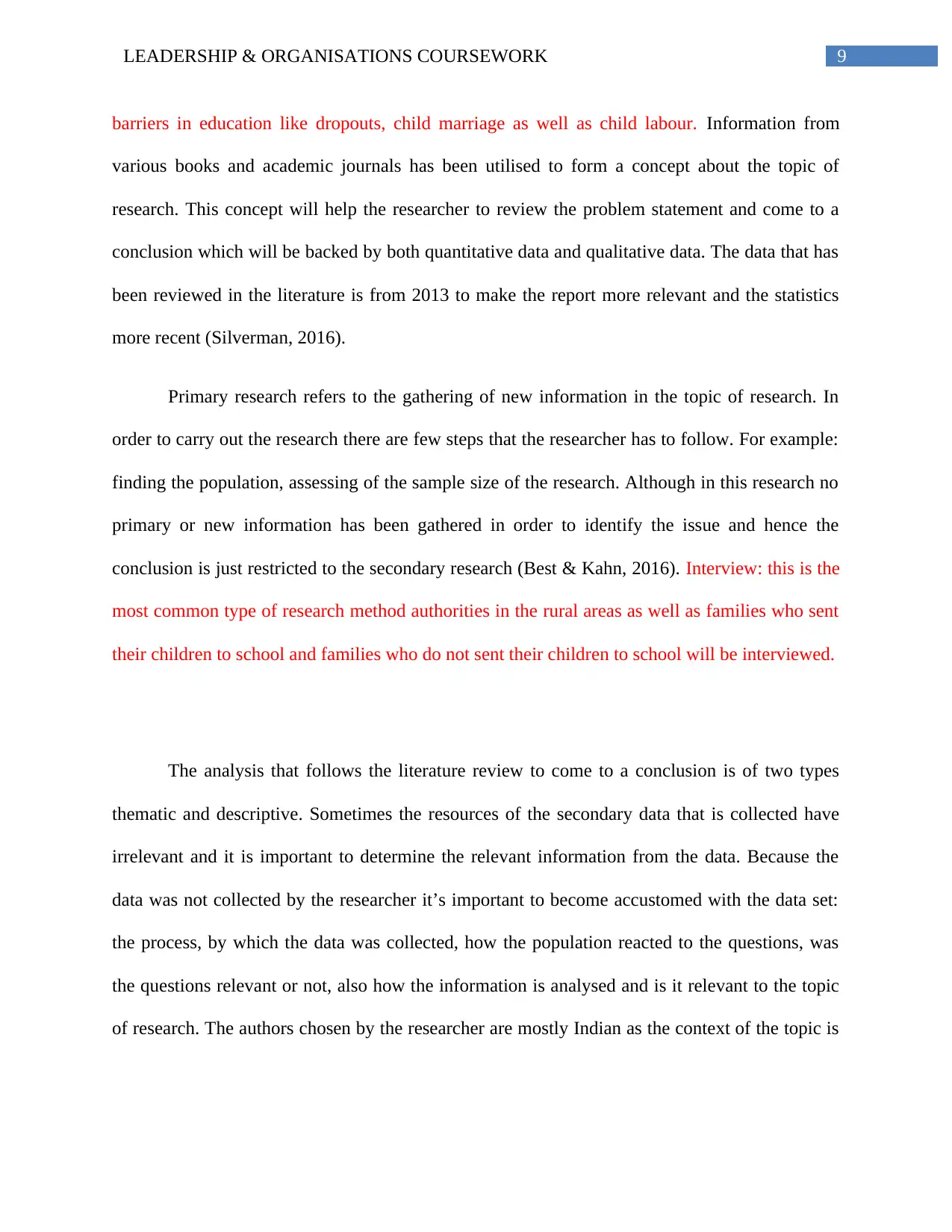
9LEADERSHIP & ORGANISATIONS COURSEWORK
barriers in education like dropouts, child marriage as well as child labour. Information from
various books and academic journals has been utilised to form a concept about the topic of
research. This concept will help the researcher to review the problem statement and come to a
conclusion which will be backed by both quantitative data and qualitative data. The data that has
been reviewed in the literature is from 2013 to make the report more relevant and the statistics
more recent (Silverman, 2016).
Primary research refers to the gathering of new information in the topic of research. In
order to carry out the research there are few steps that the researcher has to follow. For example:
finding the population, assessing of the sample size of the research. Although in this research no
primary or new information has been gathered in order to identify the issue and hence the
conclusion is just restricted to the secondary research (Best & Kahn, 2016). Interview: this is the
most common type of research method authorities in the rural areas as well as families who sent
their children to school and families who do not sent their children to school will be interviewed.
The analysis that follows the literature review to come to a conclusion is of two types
thematic and descriptive. Sometimes the resources of the secondary data that is collected have
irrelevant and it is important to determine the relevant information from the data. Because the
data was not collected by the researcher it’s important to become accustomed with the data set:
the process, by which the data was collected, how the population reacted to the questions, was
the questions relevant or not, also how the information is analysed and is it relevant to the topic
of research. The authors chosen by the researcher are mostly Indian as the context of the topic is
barriers in education like dropouts, child marriage as well as child labour. Information from
various books and academic journals has been utilised to form a concept about the topic of
research. This concept will help the researcher to review the problem statement and come to a
conclusion which will be backed by both quantitative data and qualitative data. The data that has
been reviewed in the literature is from 2013 to make the report more relevant and the statistics
more recent (Silverman, 2016).
Primary research refers to the gathering of new information in the topic of research. In
order to carry out the research there are few steps that the researcher has to follow. For example:
finding the population, assessing of the sample size of the research. Although in this research no
primary or new information has been gathered in order to identify the issue and hence the
conclusion is just restricted to the secondary research (Best & Kahn, 2016). Interview: this is the
most common type of research method authorities in the rural areas as well as families who sent
their children to school and families who do not sent their children to school will be interviewed.
The analysis that follows the literature review to come to a conclusion is of two types
thematic and descriptive. Sometimes the resources of the secondary data that is collected have
irrelevant and it is important to determine the relevant information from the data. Because the
data was not collected by the researcher it’s important to become accustomed with the data set:
the process, by which the data was collected, how the population reacted to the questions, was
the questions relevant or not, also how the information is analysed and is it relevant to the topic
of research. The authors chosen by the researcher are mostly Indian as the context of the topic is
⊘ This is a preview!⊘
Do you want full access?
Subscribe today to unlock all pages.

Trusted by 1+ million students worldwide
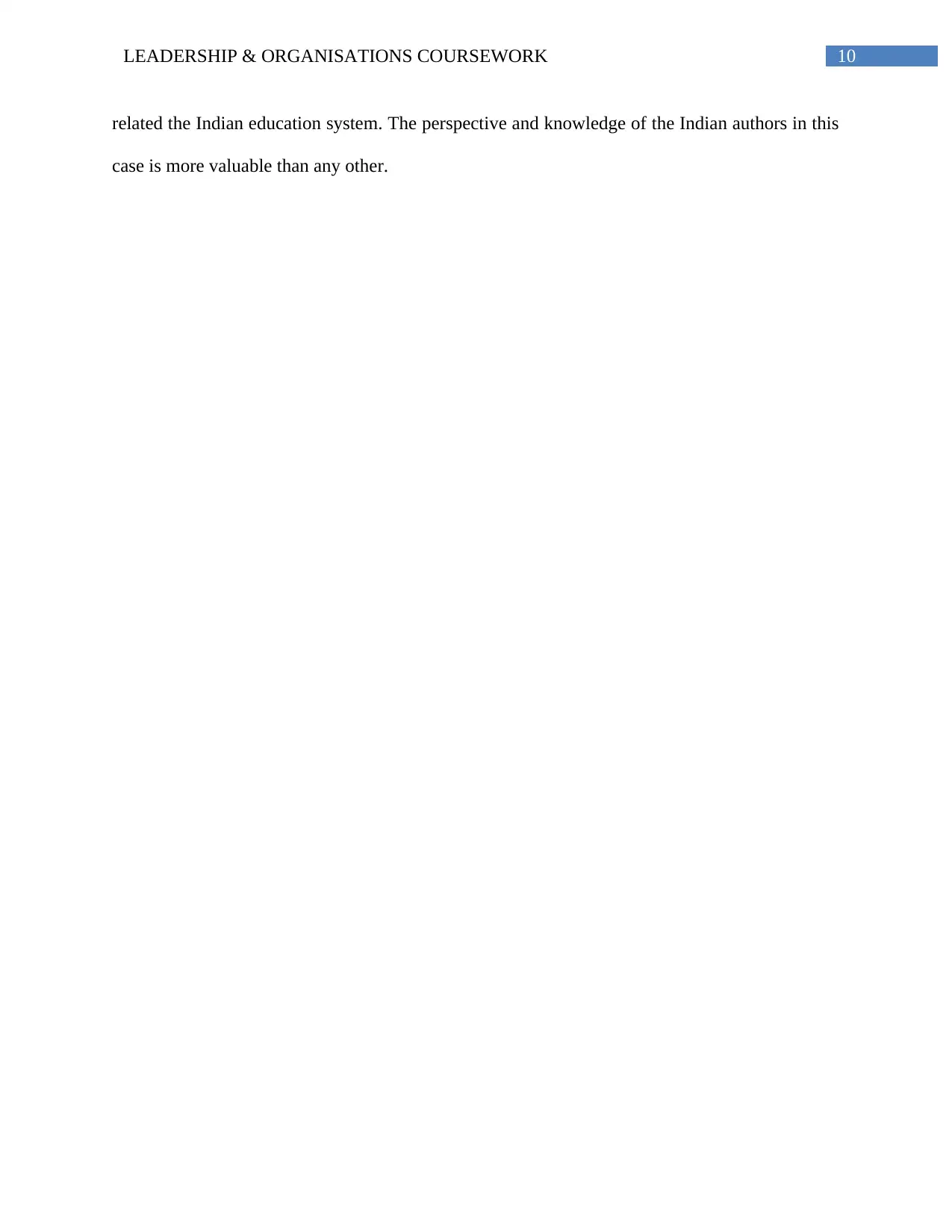
10LEADERSHIP & ORGANISATIONS COURSEWORK
related the Indian education system. The perspective and knowledge of the Indian authors in this
case is more valuable than any other.
related the Indian education system. The perspective and knowledge of the Indian authors in this
case is more valuable than any other.
Paraphrase This Document
Need a fresh take? Get an instant paraphrase of this document with our AI Paraphraser
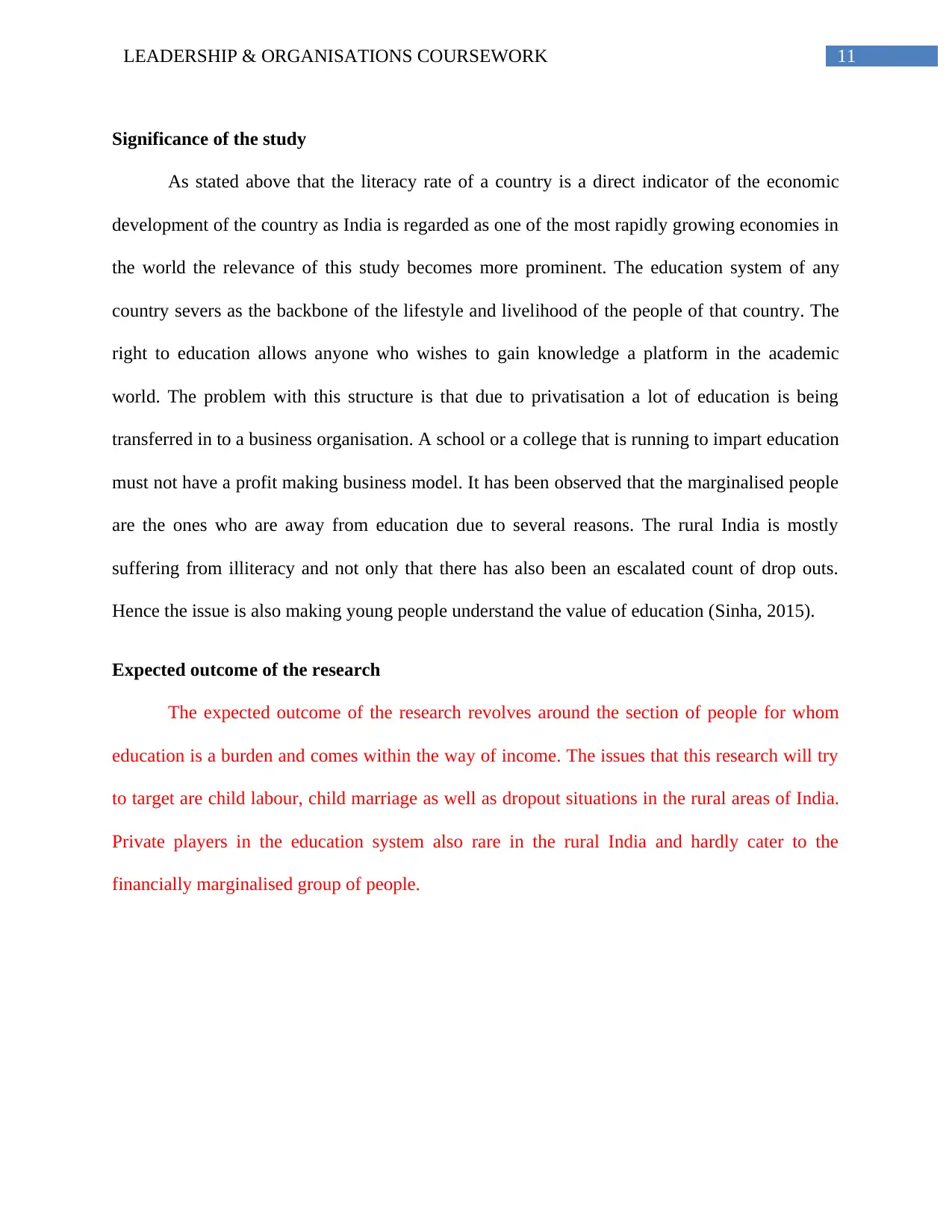
11LEADERSHIP & ORGANISATIONS COURSEWORK
Significance of the study
As stated above that the literacy rate of a country is a direct indicator of the economic
development of the country as India is regarded as one of the most rapidly growing economies in
the world the relevance of this study becomes more prominent. The education system of any
country severs as the backbone of the lifestyle and livelihood of the people of that country. The
right to education allows anyone who wishes to gain knowledge a platform in the academic
world. The problem with this structure is that due to privatisation a lot of education is being
transferred in to a business organisation. A school or a college that is running to impart education
must not have a profit making business model. It has been observed that the marginalised people
are the ones who are away from education due to several reasons. The rural India is mostly
suffering from illiteracy and not only that there has also been an escalated count of drop outs.
Hence the issue is also making young people understand the value of education (Sinha, 2015).
Expected outcome of the research
The expected outcome of the research revolves around the section of people for whom
education is a burden and comes within the way of income. The issues that this research will try
to target are child labour, child marriage as well as dropout situations in the rural areas of India.
Private players in the education system also rare in the rural India and hardly cater to the
financially marginalised group of people.
Significance of the study
As stated above that the literacy rate of a country is a direct indicator of the economic
development of the country as India is regarded as one of the most rapidly growing economies in
the world the relevance of this study becomes more prominent. The education system of any
country severs as the backbone of the lifestyle and livelihood of the people of that country. The
right to education allows anyone who wishes to gain knowledge a platform in the academic
world. The problem with this structure is that due to privatisation a lot of education is being
transferred in to a business organisation. A school or a college that is running to impart education
must not have a profit making business model. It has been observed that the marginalised people
are the ones who are away from education due to several reasons. The rural India is mostly
suffering from illiteracy and not only that there has also been an escalated count of drop outs.
Hence the issue is also making young people understand the value of education (Sinha, 2015).
Expected outcome of the research
The expected outcome of the research revolves around the section of people for whom
education is a burden and comes within the way of income. The issues that this research will try
to target are child labour, child marriage as well as dropout situations in the rural areas of India.
Private players in the education system also rare in the rural India and hardly cater to the
financially marginalised group of people.
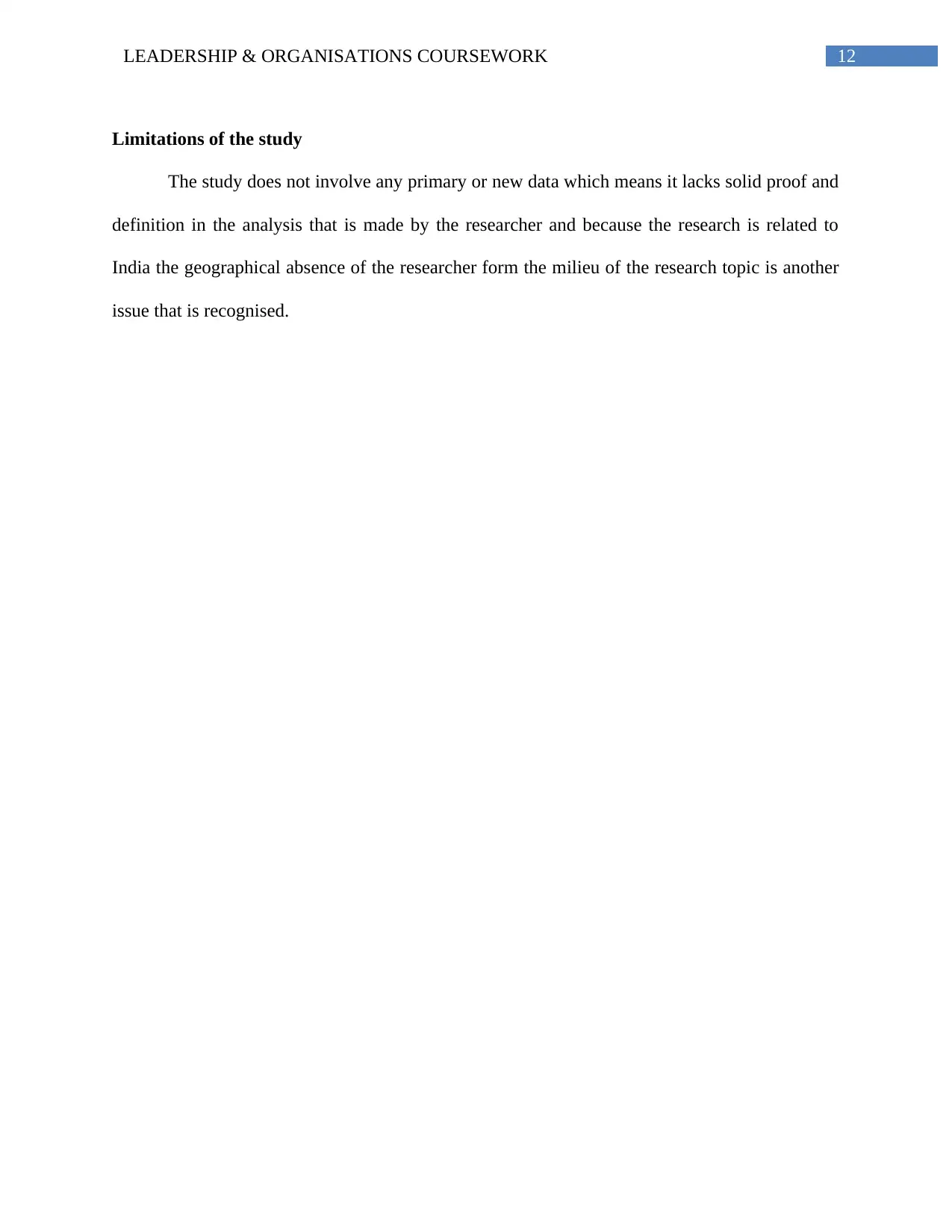
12LEADERSHIP & ORGANISATIONS COURSEWORK
Limitations of the study
The study does not involve any primary or new data which means it lacks solid proof and
definition in the analysis that is made by the researcher and because the research is related to
India the geographical absence of the researcher form the milieu of the research topic is another
issue that is recognised.
Limitations of the study
The study does not involve any primary or new data which means it lacks solid proof and
definition in the analysis that is made by the researcher and because the research is related to
India the geographical absence of the researcher form the milieu of the research topic is another
issue that is recognised.
⊘ This is a preview!⊘
Do you want full access?
Subscribe today to unlock all pages.

Trusted by 1+ million students worldwide
1 out of 15
Related Documents
Your All-in-One AI-Powered Toolkit for Academic Success.
+13062052269
info@desklib.com
Available 24*7 on WhatsApp / Email
![[object Object]](/_next/static/media/star-bottom.7253800d.svg)
Unlock your academic potential
Copyright © 2020–2025 A2Z Services. All Rights Reserved. Developed and managed by ZUCOL.





